

SHIPPER’S GUIDE
Your resource for freight services, classification, shipping, and more





Your resource for freight services, classification, shipping, and more


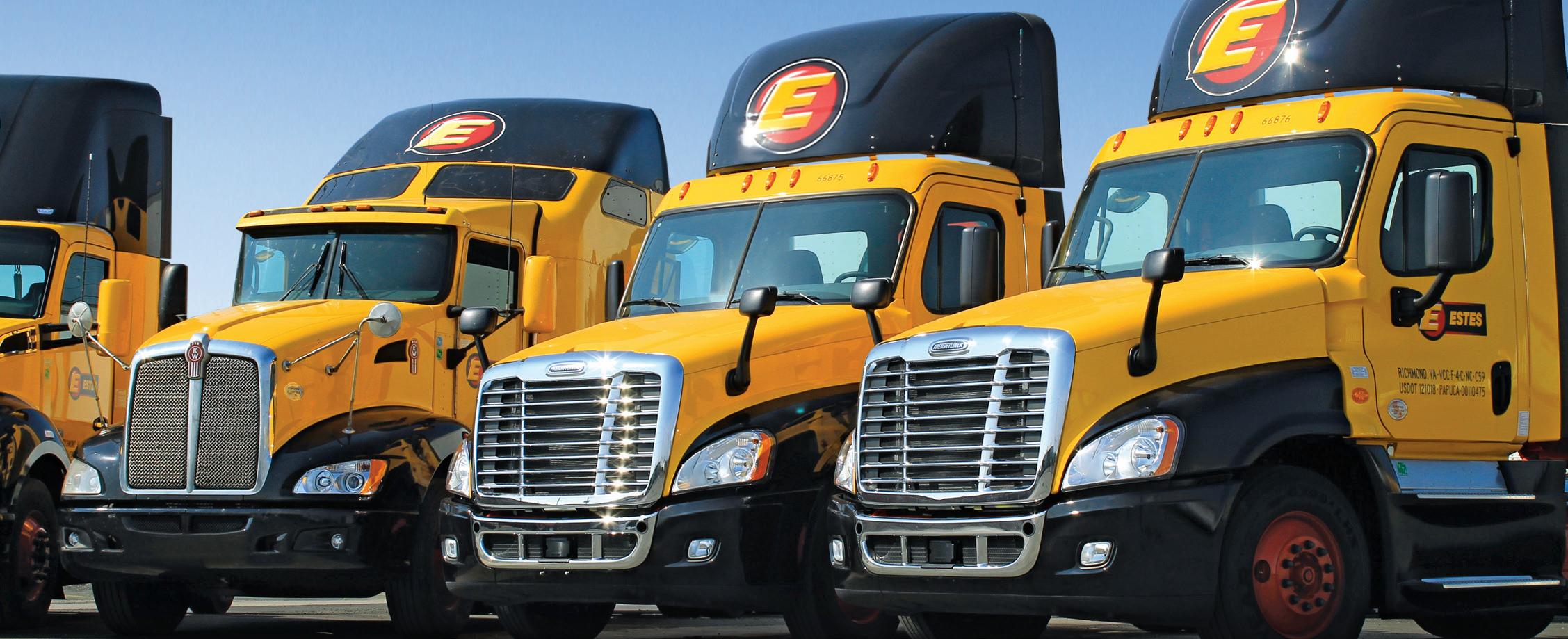
We deliver LTL solutions throughout all 50 states, Canada, Mexico, Puerto Rico, and the Caribbean. And our nationwide terminal network offers nearly 7,000 next-day lanes and 750 million one- and two-day shipping points. From shorthaul to long-haul, Estes does it all.
Our best-in-class Time Critical Guaranteed service includes more standard benefits than you’ll find with any other carrier, including guaranteed on-time pickups, on-time appointments, on-time delivery, and damage-free shipments. This makes it the perfect solution for your Must Arrive By Date (MABD) requirements because it guarantees all aspects of your shipment from on-time pickup to damage-free delivery. And our Estes Retail Guarantee product delivers exceptional peace of mind by mitigating chargeback fees and other financial penalties.
When you’re making a larger shipment, you can count on Estes’ vast terminal network, robust fleet, and nearly 7,000 next-day lanes to keep your freight moving. We offer volume LTL shipping service for your partial truckloads and asset-based solutions for your truckload freight.
Estes provides a variety of services to meet our customers’ unique shipping needs, including home deliveries to your retail customers, and non-dock deliveries to locations without a loading dock, such as restaurants, retail stores, and construction sites.
Estes is committed to investing in technology that makes freight shipping easy. That’s why we designed our My Estes shipping tools to move you seamlessly between our Rate Quote, Bill of Lading, and Pickup Request applications for a more streamlined shipping experience. And we offer realtime pickup visibility, enhanced shipment tracking, and other intuitive digital solutions.
Need to make an offshore shipment? Estes has you covered. We provide frequent, reliable sailings to and from Alaska, Hawaii, Puerto Rico, and the Caribbean. And because keeping your cargo safe is important to us, we make sure your freight is secured for optimal protection on the high seas.
Estes ships to virtually all points in Canada and Mexico and offers reliable next-day service to many Canadian destinations. Whether your freight is headed north or south, we have dedicated Border Concierges to help prevent unexpected hassles and delays. Estes makes it easy to get your crossborder freight where it needs to go, when it needs to get there
EFW /
When you need to ship internationally, trust a provider with flexible options and extensive reach. Through our reliable network of ocean, air, and ground services, EFW delivers international freight shipping solutions to virtually anywhere in the world.
No two supply chains are alike. That’s why we offer a full range of custom supply chain and logistics solutions tailored to your specific needs, including dedicated fleet services, logistics centers services, product rollouts, and more.
Our user-friendly, interactive website, estes-express.com provides access to all the tools and resources you need to manage your shipments at any time, from anywhere.
My Estes is a secure portal that houses account-specific applications to make freight shipping even easier. The portal offers a range of helpful resources to streamline the shipping process, including virtual walkthroughs, tooltips, howto guides, and more. Once registered, you’ll have access to our full suite of applications, including:
• Rate Quotes and History
• Bill of Lading
• Pickup Request
• Commodity Library
• Pickup Visibility
• Shipment Tracking
• Shipment Manifest
• Document Retrieval
• Online Reporting
• Claims Filing and Inquiry
• Invoice Inquiry
• Rating and Billing Discrepancies
Don’t have a My Estes account? Sign up for free today!
Our APIs are a fast and easy way to integrate our shipping functionality into your business applications and websites. Each API provides access to Estes functionality, allowing you to bypass the traditional HTML forms process and make shipping with Estes a more convenient solution. Our APIs include Rate Quote, Bill of Lading, Pickup Request, Pickup Status Visibility, Shipment Tracking, Image Retrieval, and Transit Time Calculation.
Our Electronic Data Interchange (EDI) allows you to send and receive shipment and billing information automatically via a secure, direct connection between your computer system and ours.
Benefits include:
• Increased efficiency
• Reduced administrative costs
• Reduced paper flow and handling
• Fewer manual interventions
• No redundant data entry
We offer the following EDI sets:
• 204 – Send a shipment tender/pickup electronically
• 211 – Send a Bill of Lading electronically
• 210–Receive electronic invoices
• 214–Receive automatic messages regarding shipment status
• 820–Apply payments to your account electronically
Other data sets may also be available.


Estes handles thousands of hazardous material shipments every day, and we train our employees to treat these shipments with the same care you would expect from members of your own team.
Estes also uses the Hazmat Trucking Enforcer (HTE) software to ensure trailers carrying hazardous materials are properly placarded. Should an incident occur, visible placards can make all the difference in the quick containment of a hazmat emergency.
When you ship hazardous materials, how do you ensure you’re complying with federal regulations?
First , choose a carrier who knows the regulations and trains its employees in the proper handling of hazardous materials.
Second, make sure the carrier handles the hazardous material you wish to ship. Due to permitting requirements, many carriers are not handling every hazardous material. For a complete list of items Estes does not haul, go to estes-express.com/resources/hauling-exclusions.
Third, properly prepare your shipping paper and mark and label your shipment.
Finally, be sure to investigate the qualifications of the carrier you choose.
This is only a general overview of Hazmat transportation. For specific requirements, be sure to consult the Hazardous Material Regulations issued by the Department of Transportation.
Placarding Options


Hazardous Materials Certificate (below):
(All certificates for Estes and Estes West can be viewed in our Shipping Forms and Documents page at our website)
UNITED STATES OF AMERICA
DEPARTMENT OF TRANSPORTATION
PIPELINE AND HAZARDOUS MATERIALS SAFETY ADMINISTRATION

HAZARDOUS MATERIALS
CERTIFICATE OF REGISTRATION FOR REGISTRATION YEAR(S) 2024-2027
Registrant: ESTES EXPRESS LINES
ATTN: David Ondik PO BOX 25612
RICHMOND, VA 23260
This certifies that the registrant is registered with the U.S. Department of Transportation as required by 49 CFR Part 107, Subpart G.
This certificate is issued under the authority of 49 U.S.C. 5108. It is unlawful to alter or falsify this document.
Reg. No: 050624550113GI Effective: July 1, 2024 Expires: June 30, 2027
HM Company ID: 39879
Record Keeping Requirements for the Registration Program
The following must be maintained at the principal place of business for a period of three years from the date of issuance of this Certificate of Registration:
(1) A copy of the registration statement filed with PHMSA; and (2) This Certificate of Registration
Each person subject to the registration requirement must furnish that person's Certificate of Registration (or a copy) and all other records and information pertaining to the information contained in the registration statement to an authorized representative or special agent of the U. S. Department of Transportation upon request.
Each motor carrier (private or for-hire) and each vessel operator subject to the registration requirement must keep a copy of the current Certificate of Registration or another document bearing the registration number identified as the "U.S. DOT Hazmat Reg. No." in each truck and truck tractor or vessel (trailers and semi-trailers not included) used to transport hazardous materials subject to the registration requirement. The Certificate of Registration or document bearing the registration number must be made available, upon request, to enforcement personnel.
For information, contact the Hazardous Materials Registration Manager, PHH-52, Pipeline and Hazardous Materials Safety Administration, U.S. Department of Transportation, 1200 New Jersey Avenue, SE, Washington, DC 20590, telephone (202) 366-4109.
E X A MPL E OF H A Z A RDOUS M AT ERI A L S SHIPPING PA PER T Y PE OF PAC K AGE S M AY BE ABBRE V IATED COLUMN CAP TIONED HM TO L EF T OF BASIC DESCRIP TION SIGNED SHIPPER CER T IF IC AT ION
A Z A RDOUS SUBS TA NCE S
0 X CYL, UN 1066, NITROGEN COMPRESSED, 2
X DRUM,
EXAMPLE
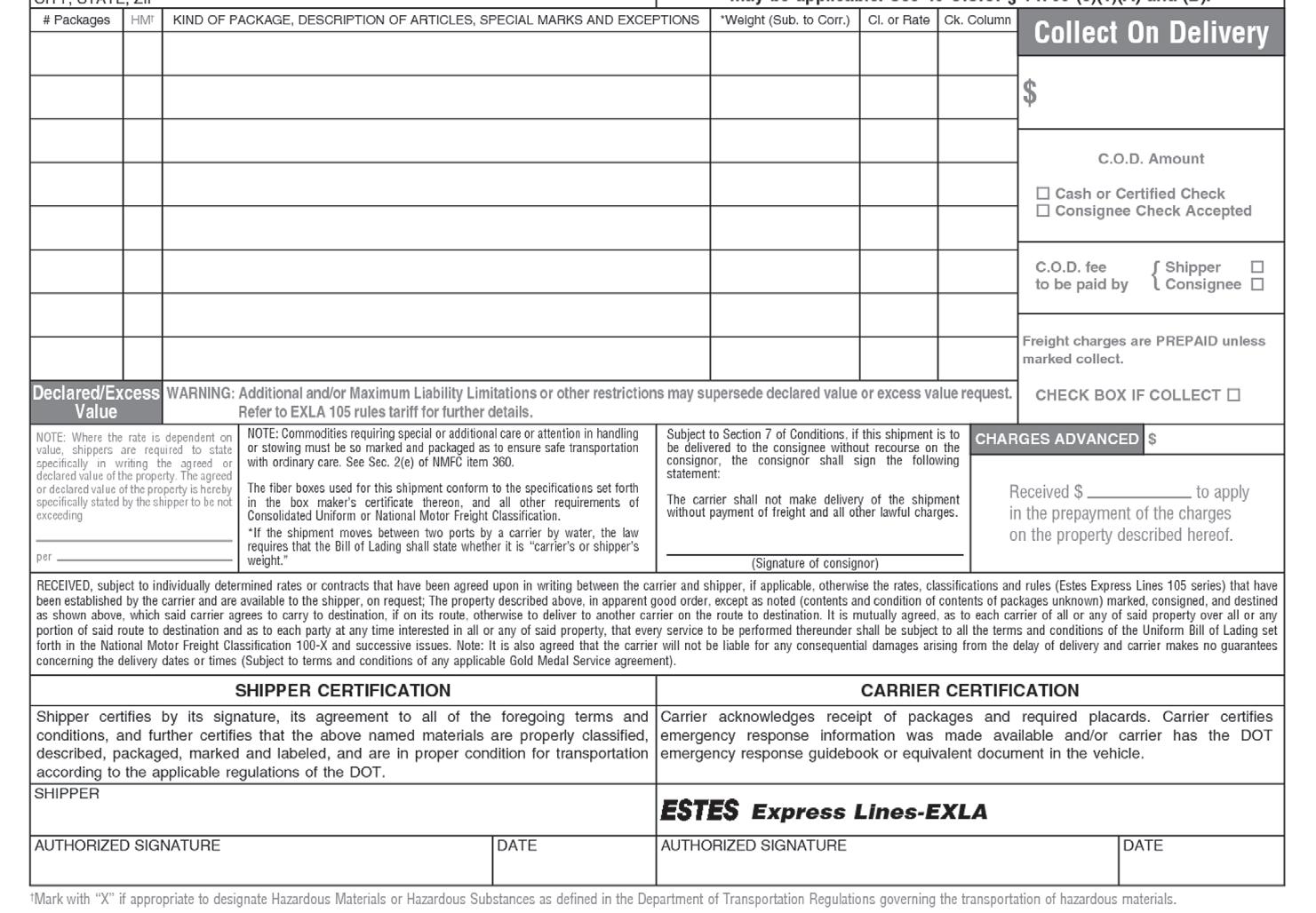
Sample Hazardous Materials Shipping Paper
Below: Examples of Hazardous Class Labels


The following services are covered by our basic pricing package for U.S. shipments:
• Direct shipping to all points in our service area
• Free time to load and unload based on the size of your shipment
• Limitation of Liability—varies with the class of the commodity, $5 per pound and a maximum of $50,000 per shipment
• Pickup and delivery at business locations during Estes’ business hours (Terminal hours vary—please contact your local terminal for pickup and delivery times.)
The shipper or receiver is responsible for loading and unloading shipments over 500 pounds or with difficult-tohandle configurations. In order to unload packages or units that weigh between 110 and 500 pounds, our driver needs direct access to the rear of our trailer and your dock. If there is no direct access, driver assistance is available for a fee.
Prices quoted by Estes are subject to tariffs. All rate quotes are conditioned upon the information provided by the requester.
Please contact your account manager if you have specific pricing questions.
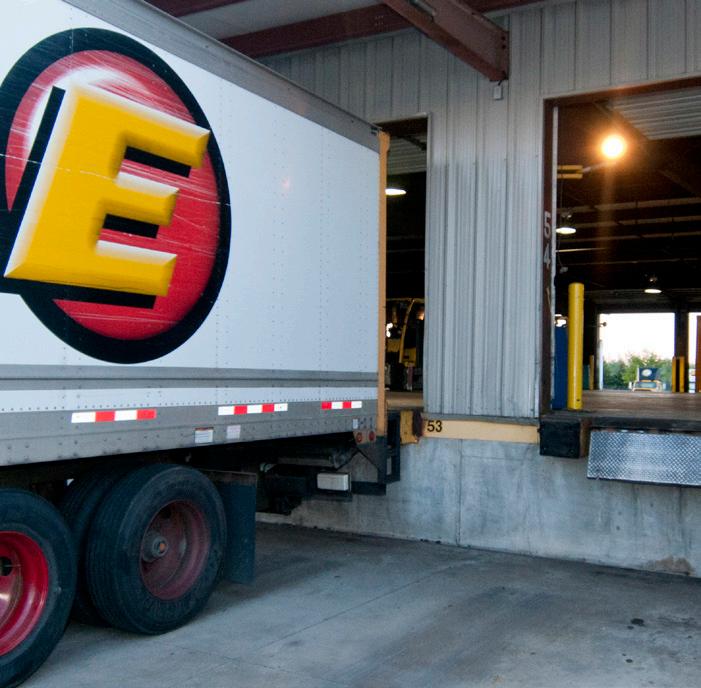

The following explains how to determine a minimum shipment charge for shipments that exceed 350 cubic feet:
• Multiply the cubic feet by six pounds to determine the calculated weight
• Multiply the calculated weight by the current Class 125 rate for the origin to destination on the shipment to determine the gross charge
• Subtract your discount percentage (or 50% if you don’t have a discount) to determine the net minimum charge, which applies if it’s greater than the otherwise applicable charges
Capacity Loads –If the weight of your shipment matches the maximum legal weight on our trailer, or if an additional unit of the largest item in the shipment would not fit on the trailer (even if an additional unit is not tendered as part of the shipment), we consider your shipment a capacity load. Charges for capacity loads will be governed by Item 390, EXLA 105 series. This includes:
• Quantities of freight which require the entire capacity of a pup, set of pups, or vehicle exceeding 28-feet in length
• Quantities of freight which occupy 20 linear feet or more of a vehicle, or exceed 20,000 pounds
• Quantities of freight which meet the maximum legal weight or size requirements allowed by state or regulatory bodies
Shipments Originating and/or Destined for:
Alaska and Hawaii
Canada’s Alberta Oil Sands Harbor Points in WA Islands requiring ferry service
Jacob Javits Center
Las Vegas Convention Centers
McCormick Place Points in Mexico
Remote points in Canada
Richard J. Daley Center
Select ZIP Codes
Household Goods
Pieces 8 Feet or More in Length
Please refer to our Rules Tariff, Item 751-10
For complete details about these additional charges, please view the Estes’ Rules Tariff, located in the Resources section of our website at estes-express.com. Or feel free to contact the LTL Rate Quote Department at 804-353-1900, Ext. 2269 .
Accessorials are additional services
Estes can provide which go above and beyond those included in our standard delivery service. Accessorial services are usually not included in our standard shipment rates and are billed as additional charges, with any exceptions noted in specific pricing agreements or contracts for individual Estes customers. Please see our Rules Tariff for more comprehensive accessorial details as well as any limitations or restrictions. A few of our most applied accessorial services are:
California Compliance Surcharge: Shipments to or from the state of California will be subject to a standard fee per shipment, in addition to all other applicable charges
Hazardous Materials Charge: Estes can handle shipments containing hazardous materials, subject to DOT regulations
Liftgate: The consignee can request a power-operated tailgate, capable of lifting a load from street level to the level of a truck or trailer floor, or vice versa
Residential/House Delivery Charge (Prepaid and Collect): The shipper can request a pickup or delivery at a non-commercial or residential location
Appointment/Notification: Estes can accommodate shippers who need to be notified of delivery prior to their scheduled delivery time
Overlength: When a handling unit equals or exceeds eight feet in length, Estes can configure the load to accommodate
Remote Access: Pickup or delivery to points that due to geography (deserts, islands, lakes, mountains), limited highway access, or sparse populations, require the use of an agent
Service Requested By Consignee: When the consignee requires the carrier to purchase contract labor to perform the unloading service, the carrier will be reimbursed for any expenses, charges or fees assessed by the contractor
Estes is committed to meeting each of our customers’ unique shipping needs. That means we do our best to
accommodate any special requests we receive. For a more detailed list of our most used accessorial services, visit the Accessorials page in the Fees and Surcharges section of our website, estesexpress.com
The cost of diesel fuel is a major source of concern for everyone in the trucking industry. Diesel fuel is a commodity vital for operation, yet its cost is variable. When fuel prices increase dramatically, operating costs reach levels that cannot be absorbed without serious financial consequences.
To mitigate this risk, companies in the transportation industry typically implement a fuel surcharge. Although we regret having to apply this extra fee, it is necessary to preserve the financial viability of our company and maintain our excellent service standards when diesel prices become volatile.

At Estes, we note the fuel surcharge separately on our freight bill so that when there is an increase, the exact cause and amount of the increase is clear to our customers. The National Average On-Highway Diesel Price is the figure upon which we base the fuel surcharge.
The U.S. Department of Energy updates the figure every Monday. When the diesel price changes, increases or decreases in the surcharge will be effective the following Wednesday. Please note there are different charges for less-than-truckload (LTL) and truckload (TL) shipments. For more information on our fuel surcharge, visit the Fuel Surcharge page in the Fees and Surcharges section of our website, estes-express.com
Two of the most important factors that affect your shipping costs are the freight classification and the density of the shipment.
To correctly rate your shipment, it must be classified in accordance with the National Motor Freight Classification (NMFC) standards. The NMFC is a system that evaluates commodities moving in commerce and provides classification codes and packaging requirements for each commodity. Freight classification is primarily determined by factors such as density, stowability, ease of handling, and liability.
To help simplify freight classification and improve accuracy, the NMFC has implemented a standardized density scale, consolidated thousands of NMFC item codes, and expanded the number of density tiers. Visit nmfta.org to learn more.
To ensure you receive the most accurate rates for your shipment and Estes is able to determine which commodities are being shipped, please include the following on your BOL:
• A clear description of each commodity
• Its NMFC item number or its classification
• Accurate shipment dimensions and weight, showing the density
o Some classifications require that the shipper either declare the density on the BOL or include a statement of the released value
Density is calculated by measuring a shipment’s height, width, and length. Those dimensions are then multiplied to obtain the cubic dimension of the shipment in inches.
For example: If the length is 25”, the width is 24”, and the height is 23”, those dimensions would be multiplied as follows: 25 X 24 X 23 = 13,800 cubic inches.
Next, cubic inches would be converted to cubic feet by dividing the cubic inch total by 1,728—the number of cubic inches in one cubic foot.
For example: 13,800 ÷ 1,728 = 7.98 cubic feet.
Dividing the weight of the shipment by the number of cubic feet would provide the density.
For example: 90 pounds ÷ 7.98 = 11.27 pounds per cubic foot.
The cubic dimensions of a palletized shipment is determined by combining the pallet dimensions with the shipment.
For example: If the pallet is 46” long, 42” wide, and 6” high, the height of the pallet would be added to the height of the shipment (23”) for a combined height of 29”.
The dimensions would then be multiplied like before but with the new height: 46 X 42 X 29 = 56,028 cubic inches.
Next, the total cubic inches would be converted to cubic feet by dividing 56,028 by 1,728, which equals 32.42 cubic feet.
The density would then equal the weight of 120 (90 pounds for the shipment and approximately 30 pounds for the pallet), divided by the number of cubic feet.
For example: 120 ÷ 32.42 = 3.70 pounds per cubic foot.
You can easily determine your shipment’s density and class by using our Class and Density Calculator. Scan the QR code to get started!
The density of a cylindrical object, or any article that is not square, rectangular, or elliptical, is determined by multiplying the greatest dimension on the cylindrical plane by itself, then that result is multiplied by the object’s height or length. If the value is in cubic inches, the number is divided by 1,728 cubic inches, and that answer will provide the cubic dimension. As mentioned above, dividing the weight by cubic dimension (the number of cubic feet) will provide the density.
For example: A drum that is 24” in diameter and 36” tall would have the following density:
24” X 24” X 36” = 20,736 cubic inches. 20,736 ÷ 1,728 = 12 cubic feet.
100 pounds ÷ 12 cubic feet = 8.33 pounds per cubic foot.
Any shipment that exceeds 350 cubic feet of a trailer will be subject to a minimum charge based on 6 pounds per cubic foot at the customer’s applicable class 125 rate, and using the customer’s discount. A minimum discount of 50% will apply if the customer does not have one.
For example: A shipment occupying 350 cubic feet and moving between Richmond, VA (zip: 23230) and Dallas, TX (zip: 75201) would be subject to a minimum charge, as follows: 350 cubic feet at 6 pounds per cubic feet equals 2,100 pounds.
2,100 pounds multiplied by $67.71 cwt equals $1421.91.
$1421.91 discounted by 55% produces a minimum charge of $639.86.
These figures are used for example only and may not reflect actual charges for any shipment. Charges are subject to change. Contact our LTL Rate Quote Department for current rates at 804-353-1900, Ext. 2269 . Questions specific to cubic capacity guidelines should go to your local account manager. To learn more about dimensioners and how we use them to measure the cubic capacity of your freight, see our Dimensions and Weights FAQs on our website, estes-express.com
If you’re shipping freight that takes up a lot of space in the trailer, you may be subject to an Overlength Charge. At Estes, shipments containing an article (or articles) with dimensions that:
• equal or exceed eight (8) feet in length but are less than twelve (12) feet in length are subject to a charge of $225.00 per shipment
• equal or exceed twelve (12) feet in length but are less than sixteen (16) feet in length are subject to a charge of $400.00 per shipment
• equal or exceed sixteen (16) feet in length but are less than twenty (20) feet in length are subject to a charge of $750.00 per shipment
• equal or exceed twenty (20) feet in length are subject to a charge of $1000.00 per shipment
These charges are billed in addition to all other applicable charges, and will be collected from the party responsible for paying the freight invoice.
Current insurance certificates can be obtained by contacting the Estes Safety Department. You can call 804-353-1900, Ext. 2243, or email safetydepartment@estes-express. com
The Safety Department will contact the insurance company and have the insurance certificate sent directly to you. Therefore, you must include your complete mailing address in order for the certificate to be issued. The insurance company can fax a copy, but the original must be mailed to the certificate holder. The approximate time for the certificate to be issued is 48 hours.
If you are shipping goods that need to maintain above freezing temperature throughout transit to preserve quality, Estes can keep your freight above freezing for an additional charge.
Estes offers PFF services:
• Nov. 1 - March 31 for domestic shipments and Sept. 15 - May 15 for Canadian shipments (Service periods may be extended depending upon weather conditions)
• when suitable equipment is available
• when the outside temperature is above 10 degrees Fahrenheit for shipments moving in all direct lanes
• the BOL and freight are clearly labeled, indicating the need for protection from freezing
• the commodities being shipped have a freezing point of 32 degrees or less
Charges for PFF services will be $3.50 cwt , subject to a minimum charge of $45.00, in addition to other applicable rates and charges.

When shipping your goods, be sure to use proper packaging techniques to avoid damages and claims:
• Stack the pallet vertically to maximize carton strength
• Stack cartons squarely on the skid with minimum overhang
• Add sheets of cardboard between each layer for additional strength
• Make sure the top surface is flat
• Secure cartons to the pallet with banding, stretch-wrap, or breakaway adhesive
To ensure safe and damagefree transit, crate your shipments. Please be sure your crates are constructed to withstand the normal rigors of freight transportation.
• Fasten crated contents to the base
• Fully enclose the product, and show how the product should be loaded with arrows or other directional indications
• Nail or screw into the side grain of the crate
• Staple labels to crates instead of using gummed labels, as these do not adhere to wood
To prevent freight from shifting, uneven surfaces should always be leveled before more freight is stacked. Freight can be
Estes will accept drums from a shipper if there are three or four drums on a pallet, and the drums are secured on the pallet by banding and/or stretch-wrap. Banding ONLY is not acceptable. Here are some rules to follow when shipping drums, pails, and bags:
DO:
• Cover the trailer floor with a layer of cardboard for protection
• Cover all sides of the freight with cardboard for protection after loading
• Label the containers as well as the stretch-wrap or banding if the drums, pails, or bags contain DOT hazardous materials
leveled by using:
• Flattened cardboard
• Other freight
• Two-by-fours
Logistic bars are used to brace freight from damaging itself, other freight, or the trailer.
These illustrations are only meant to provide a general overview of best practices in freight preparation. For more detailed information on how to package your freight, be sure to consult the Estes Rules Tariff, EXLA-105 and the NMFC.
DON’T:
• Stack pails more than two high
• Place pails between two skids
• Load stacked pails in the rear 7 to 10 feet of the trailer
Accurately labeling your freight is one of the best ways to ensure your shipment gets from its origin to its destination without delays.
Required details to include on your shipping labels:
• PRO number
• Consignee address (street, city, state, and ZIP code)
• Time Critical Guaranteed service (if applicable)
Adding a reference number like a Shipment ID, BOL, or PO number can also help us move your freight more efficiently. And if you are shipping multiple handling units, write the quantity on each unit’s shipping label, such as 1 of 2 and 2 of 2.

Be sure to place the shipping labels where they can be easily seen, such as on the sides and top of your freight and on the inside and outside of the pallet wrap.
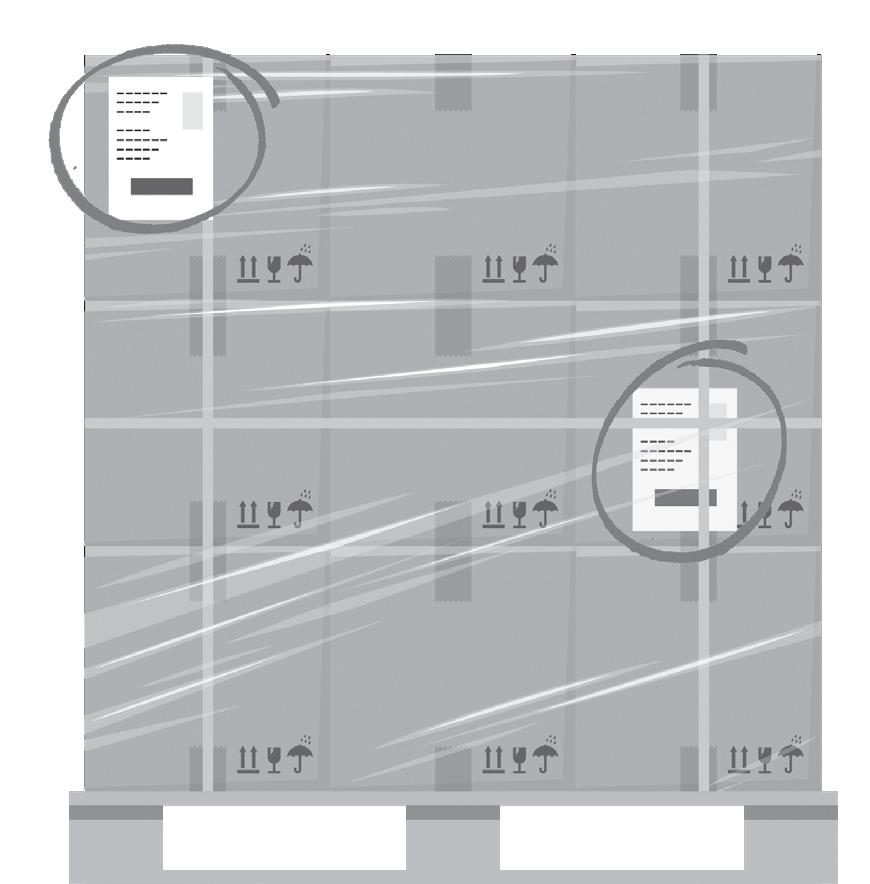

The shipping label information should be synchronized with the Bill of Lading document. Any discrepancies are to be corrected prior to pickup, and any out-of-date labels should be removed or sufficiently covered to reflect the most recent destination information.
DOT hazardous material labels and marking requirements must be used when shipping hazardous materials.

A Bill of Lading (BOL) is a legal document that transfers the responsibility of your freight over to Estes during its shipping journey. A BOL is required for all freight shipments and plays a crucial role in making sure your freight is routed and transported legally, quickly, and efficiently. It is the shipper’s responsibility to complete the BOL, and to read and understand all rules, regulations, contracts, and tariffs in effect on the date of the shipment.
When filling out a BOL, there are a few important things to keep in mind:
• If your freight charges are being billed to a third-party payer, be sure to provide the name and address of the third party
• Be as accurate and specific as possible in the description of your shipment contents. Include the National Motor Freight Classification (NMFC) item number, if known
• Be sure to provide an accurate weight and class for your shipment. If inaccuracies are found on the BOL, these details are subject to correction by Estes
• If your shipment isn’t marked as prepaid or collect, it will automatically move as prepaid
Estes provides you two BOL options:
1. Our online BOL tool is available through our secured portal, My Estes, and can be completed and submitted online.
2. A downloadable BOL form is available in the Resources section of estes-express.com on our Shipping Forms and Documents page.
On our website’s Bill of Lading page, you’ll log into your My Estes account (or sign up for a new account), select the option to “Create BOL,” and enter your shipment details. Our My Estes BOL tool is designed to simplify your shipping experience by providing you with convenient features not available on a downloadable BOL form. Give it a try today to:
Auto-assign a PRO number to your shipment

Opt-in to receive email notifications
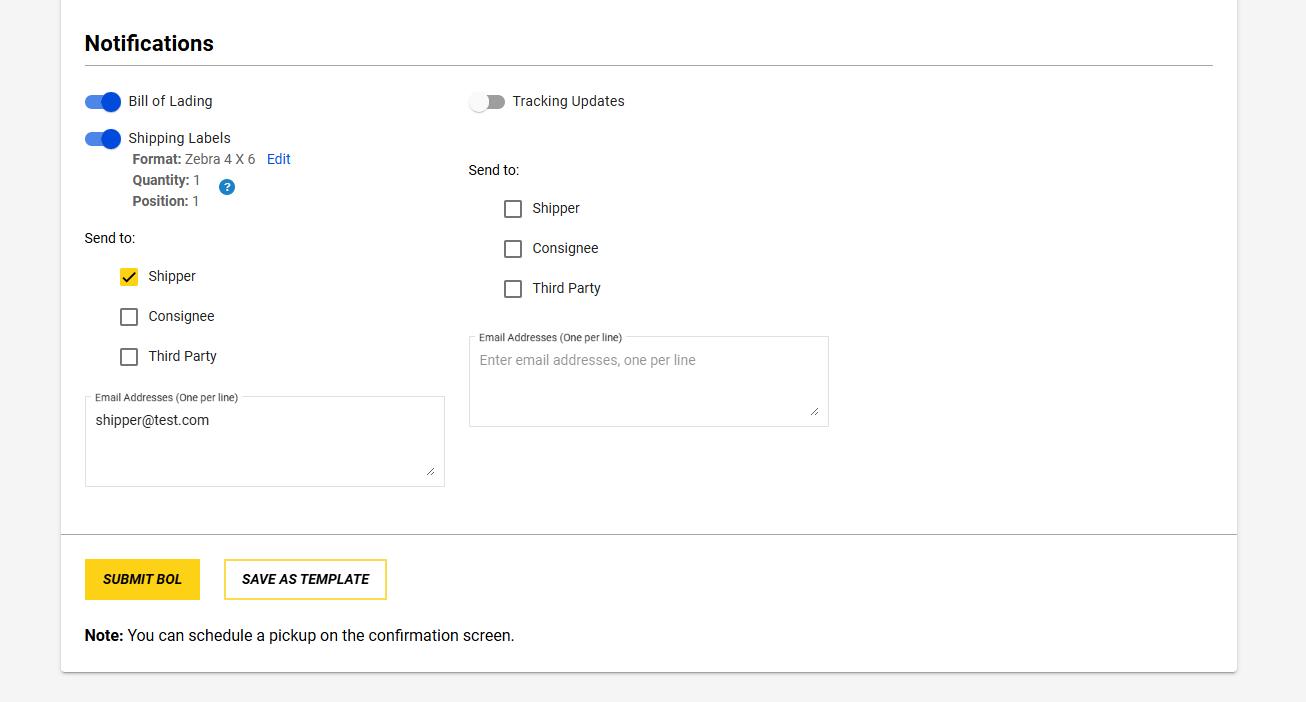
Save your existing BOL as a template for future shipments
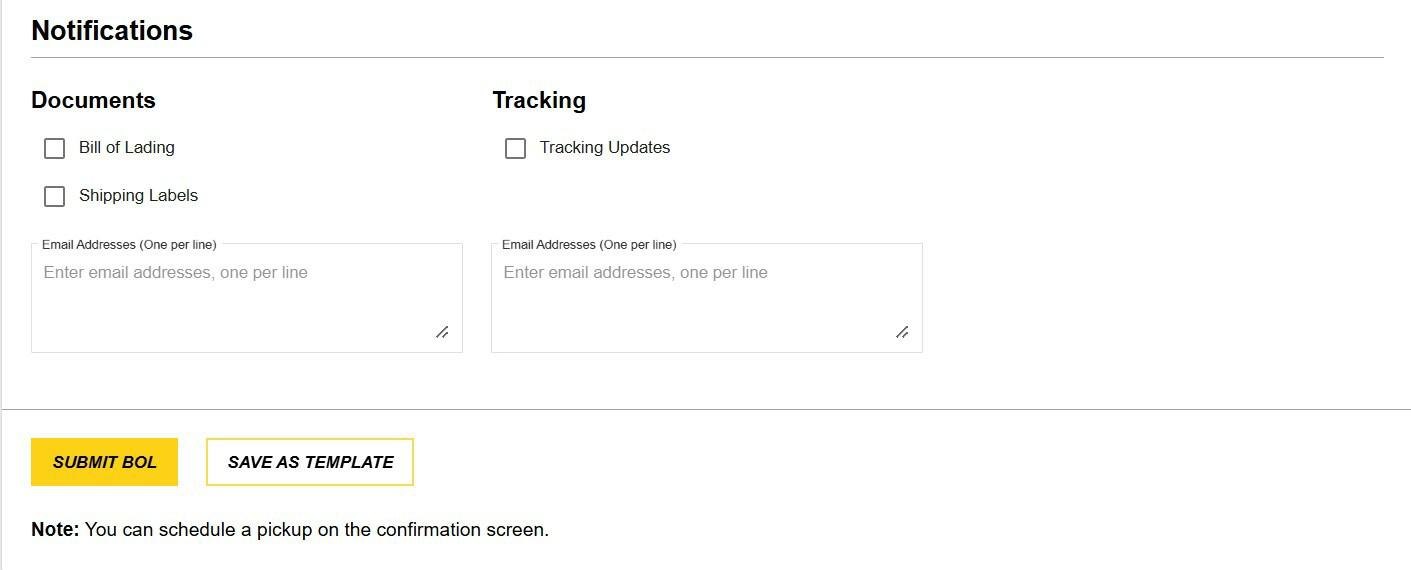
Schedule a pickup request straight from the BOL confirmation screen
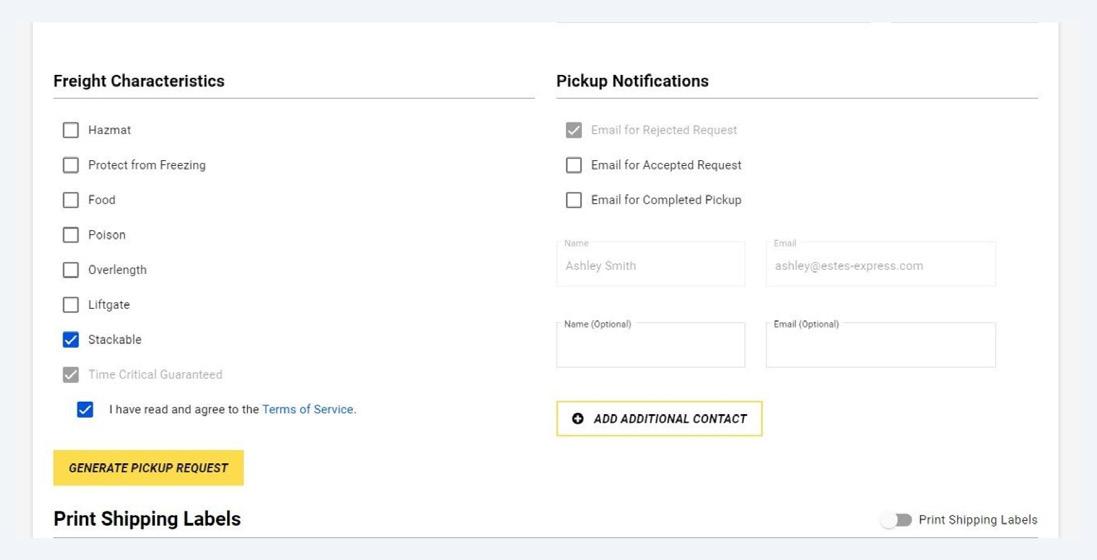
Print shipping labels quickly and easily
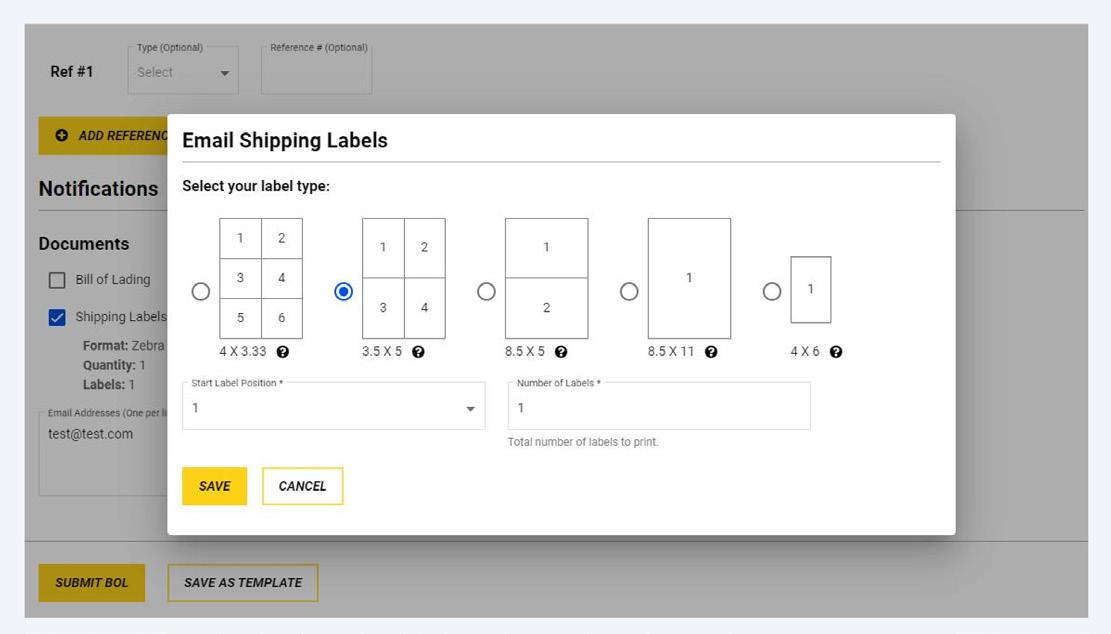
If you don’t have a My Estes account or prefer to complete your Bill of Lading by hand, you can download a BOL form by visiting the Shipping Forms and Documents page in our Resources section at estes-express.com
Full Value Coverage (FVC) can be requested in multiple ways:
• Bill of Lading form: Clearly write “Full Value Coverage” as well as the invoice value
• Rate Quote tool: Check the “I would like Full Value
Coverage” box in the Freight Information section and enter the coverage amount
• Rate Quote Results screen: Click “Calculate Coverage” in the “Affordable Cargo Protection” box and enter your desired coverage amount. It will be added to your quote
• Bill of Lading tool: Check the “I would like Full Value Coverage” box in the Freight Information section and enter the coverage amount
Full Value Coverage offers several benefits:
• Your shipment will be covered at the invoice value
• Your shipment will be protected from losses caused by Acts of God or natural disasters
• Concealed damage will be covered when reported within five days of delivery
For more details, visit our FVC web page and see ITEM 350, Section 3 of our Rules Tariff
View our most up to date glossary terms at estes-express.com
Accessorial Charges: Extra charges applied for services performed above what is considered standard.
ACE (Automated Commercial Environment):
The online system developed by U.S. Customs and Border Protection to process international trade. Through ACE, a partnership between select carriers and U.S. Customs facilitates prompt and timely freight crossing between the U.S. and Canada or Mexico. Its secure data portal allows brokers and carriers to file manifests electronically and create reports using real-time data.
ACI (Advanced Commercial Information):
The ACI program is a project of the Canada Border Services Agency (CBSA) that requires all commercial cargo entering Canada to be electronically registered with the Agency to improve border security and efficiency. It specifies requirements for marine ports, airports and land-crossing points along the U.S.-Canada border. ACI provides CBSA with electronic pre-arrival information so the Agency can identify health, safety and security threats related to commercial goods before the goods arrive in Canada. Since the arrival of information is very timesensitive, all advance cargo and conveyance information from carriers must be sent via the eManifest system.
Assembly: Also known as kitting, this is the process of packaging bulk components into finished goods at a warehouse or an outsource facility. The product’s components are picked and inserted into end-use packaging.
Asset-Based Provider: A carrier that has the assets (e.g., trucks, terminals, warehouses, etc.) to provide physical pickup, line-haul and delivery service.
Authorized Party: The entity that can legally provide instructions that override those contained on the BOL. This is usually the shipper but occasionally the third party or consignee.
Backhaul: The return trip of a commercial truck that is transporting freight back over all or part of the same route it took to get to its current location.
Bill No Freight (BNF): The entire shipment is short. No freight is found on the trailer to match the shipment manifest.
Bill of Lading (B/L or BOL): A legal document signed by the shipper and carrier tendering the responsibility for the freight to the carrier. The BOL states pertinent information for the shipment such as the complete address of the shipper and consignee, number of pieces, description, class, and any hazardous
material information. The dimensions of the shipment are required if the freight is being shipped offshore.
Border Concierges: Logistics experts who guide shippers through the complexities of cross-border freight movement between the US and Canada. Estes offers Border Concierge services to help shippers with completing cross-border documentation, navigating language barriers, addressing potential issues, and ensuring a streamlined shipping experience.
Break Terminal (Breakbulk): When the pickup terminal does not have enough volume to transport full capacity loads direct to a final destination, the product is moved into Breakbulk. There, freight is consolidated from several terminals to build full loads for longerhaul lanes.
Certificate of Origin: A document attesting to the country of origin for goods. Customs authorities often require it as a part of the entry process into another country.
City Driver (P&D Driver): A driver responsible for making pickups and deliveries from a specific terminal location. These drivers usually operate within a defined geographical area. They make deliveries in the morning and pick up freight in the afternoon.
City Run (Pedal Run): A route in which the driver stays within the boundaries serviced by the terminal.
Class: A numeric rating assigned to products based on their value/liability, packaging, density, and handling characteristics. The NMFC uses a 13-class system, ranging from Class 50 to Class 500 and based primarily on freight density, to determine shipping rates.
Collect (COL): Freight charges to be paid by the consignee upon delivery or charged to their established account.
Commercial Invoice: A document identifying the seller and the buyer of goods or services. It cites dates, payment terms and a complete listing and description of the goods or services being sold. For freight crossing national borders, customs officials often use a commercial invoice to determine the true transaction value of goods for assessment of customs duties.
Commodity: Goods shipped.
Common Carrier: Any person or company available to the general public for transportation of property by motor vehicle over regular or irregular routes in interstate and/or intrastate commerce.
Complemento Carta Porte (CCP): A required electronic document for Mexico shipments that provides detailed information about the origin, destination, contents, and route
of a shipment. It’s used to comply with government regulations and ensure legal transport of goods.
Concealed Damage/Shortage: A situation when a customer calls the carrier to declare an exception to their shipment after delivery has occurred and after the carrier has received a clear delivery receipt. The industry standard for reporting concealed damage is within 5 days after delivery.
Consignee: The designated recipient (customer) of a shipment as indicated on the Bill of Lading.
Consignor: Synonym for shipper.
Consolidation: The act of combining multiple shipments into one larger shipment going to a common destination.
Container: A large standard-sized transportation “box” for unitized freight handling with standardized equipment. The most common sizes are 20’, 40’, 45’ and 48’. Containers are lifted by crane and mounted on a chassis for road movement. When being transported on ocean vessels (ship or barge) or rail cars, containers are most often removed from the chassis and stacked.
Contract: A legal document describing the services to be rendered (and the charges and rates for such services) that must be approved and signed by an authorized Estes representative and signed by the customer. This pricing contract takes precedence over tariff rates.
Cross Dock: Typically, the unloading of materials from an inbound trailer or rail car and the immediate loading of these materials in outbound trailers or rail cars. This eliminates the need for warehousing/storage.
Cube: A term describing the space used in a trailer based on floor space and height.
Customs Broker: A licensed individual or firm generally required to act on behalf of the importer and manage customs formalities and ensure compliance with regulations. Estes’ partner Customs Brokers can help facilitate the processing of customs information, ensure proper clearance of shipments, and reduce delays.
Customs Invoice: A special invoice prescribed by the customs authorities of the importing country.
CWT: Per hundred weight. Hundred weight is equal to exactly 100 pounds.
Damage: Goods that sustain injury before, during or after transit, which can result in the shipper’s, consignee’s or carrier’s liability.
Dead Head (Dead-Heading): A shipment from one terminal to another with no applicable freight charges. This term also describes the return of an empty transportation container/
trailer to a terminal or facility (empty backhaul).
Declared Value (Code: “DEC”): Documents the total dollar value of the goods being shipped by the shipper. This is necessary when the rates applied to a shipment are based on the value of the goods.
Delivery Receipt (DR): A legal document signed by the consignee and Estes that completes the contract of carriage when the freight is received.
Density Calculation: Density of a shipment is equal to the length, times the height, times the width of the freight in inches. The product is then divided by 1,728 to convert the units to cubic feet (12’’ × 12’’ × 12’’ = 1,728 ÷ 1,728 = 1 cubic foot).
Department of Transportation (DOT): The U.S. governing body concerned about commerce that crosses state lines. Principally, this segment of the government regulates interstate truck operations.
Direct: The territory serviced directly by the Estes terminal network.
Direct Loading: Loading of shipments direct from one service center to another without an intermediate stop for rehandling.
Dispatch/Dispatcher: The scheduling and control of intercity traffic and intracity pickup and delivery. Also, the individual tasked to assign available transportation loads to available drivers.
Disposition: Authorized instructions given to a common carrier regarding the movement of a shipment.
Dolly: An auxiliary axle assembly equipped with a fifth wheel (coupling device) used to convert a semitrailer into a full trailer (or for hauling multiple trailers behind a single power unit). The dolly, or converter dolly, is towed by a semitrailer and supports the front of, and tows, another semitrailer. Also referred to as a bogie.
Drop Trailer: A situation where the carrier spots, or drops off, a trailer at the customer’s location for loading and/or unloading of freight without the presence of the carrier’s driver.
Drop Trailer Agreement: A mutual agreement in writing between the customer and Estes when a trailer is spotted for loading and/or unloading purposes.
Electronic Data Interchange (EDI): The electronic interchange of business information using a standardized format, allowing one company to send bulk information to another company electronically. Estes utilizes EDI to exchange data with customers adhering to EDI ANSI X12 guidelines. Several types of transportation documents exchanged via
EDI include (204) Pickup Tender, (211) Bill of Lading, (214) Shipment Status, (210) Invoice and (820) Remittance Advice.
Electronic Export Information (EEI): As of June 2008, freight forwarders and U.S. Principal Parties in Interest (USPPIs) must file all commodity information for exported goods via the Automated Export System, the free online filing system at www.cbp.gov/ace.
eManifest: A condition of the Canada Border Services Agency that requires trade partners in all modes of transportation (air, marine, highway and rail) to submit cargo, crew/ passenger, conveyance, secondary and importer data to the Agency no later than one hour prior to arrival at the border.
Employer Identification Number (EIN): The federal tax identification number that is the corporate equivalent to an individual’s Social Security number, issued to entities or individuals who have to pay withholding taxes on employees. Including the EIN is a requirement for many cross-border freight activities; specifically, it is required for documentation for all Puerto Rico-bound shipments coming from the U.S. Entryway Delivery: One of our premium service levels for residential delivery. The shipment will be placed through a front door into a foyer or similar area.
Estes Retail Guarantee™: An Estes service that offers retail shippers extra peace of mind by providing a financial guarantee of up to two times their freight charges should Estes miss a delivery appointment due to carrier service failure.
EXLA: The Standard Carrier Alpha Code (SCAC) or owner code for Estes.
Fifth Wheel: A coupling device mounted to a tractor or a dolly for connecting a semitrailer and a tractor, or two semitrailers. A semitrailer is supported at the rear by its own wheels and at the front by the fifth wheel, which is mounted to a tractor or dolly.
Free on Board (FOB): The point at which the title of the goods passes from the shipper to the consignee.
Freight Forwarding: A non-asset-based logistics service that arranges domestic and international transportation of cargo on behalf of shippers. Freight forwarding includes arranging ground, air, and ocean transportation, as well as services like tracking, shipping and export documentation, warehousing, cargo space booking, freight charge negotiating, consolidation, cargo insurance and claims filing. Through our subsidiary EFW, Estes offers comprehensive Global Freight Forwarding solutions to support your business’s unique international shipping needs.
Front Door Delivery: Our standard service level for residential delivery. The shipment will be delivered from the truck to the driveway, garage, or parch (covered area). This service includes text message alerts, online shipment tracking, as well as a convenient No Appointment / No Signature Required delivery experience for residential consignees.
Fuel Surcharge (FSC): An additional charge added to the freight bill for the price of fuel (according to the National Fuel Index) to offset high fuel costs.
Full Trailer: Indicates the use of an entire trailer.
Full Value Coverage: An additional protection that can be purchased to cover your shipment’s full value in the event of a claim.
Gross Weight: The entire weight of a shipment including containers and packaging materials.
Hazardous Materials (Hazmat): The Transportation Safety Act of 1974 defines hazardous material as “a substance or material in quantity and form which may pose an unreasonable risk to health and safety or property when transported in commerce.”
Hazmat Regulations: Standards set by the Research and Special Programs Administration (RSPA) Office of Hazardous Materials Transportation (OHMT) that regulate how hazardous materials are shipped.
Head Haul: The term defining shipping lanes from shipper to consignee where there typically is significant freight moving into the destination (A to B) and less freight moving out. It is the opposite of Backhaul (B to A).
High-Value Freight: Freight with a value exceeding the limitations set in the EXLA 105 series rules tariff.
Hours of Service (HOS): A ruling that stipulates the amount of time a driver is allowed to work. The Federal Motor Carrier Safety Administration enforces this ruling.
Hub: A terminal in the center of a region where freight can be loaded and unloaded to accomplish next-day delivery.
Image: An electronic visual impression of a document such as a Bill of Lading and/or a delivery receipt.
Inbound: Freight or trailers moving to or through a terminal.
Inland Charges: Rates for moving shipments within the contiguous 48 states, Canada and Mexico. Discounts and accessorial charges typically apply.
Inspection: An examination, viewing or checking over for the purpose of ascertaining the quality, authenticity or conditions of an item or product.
Interline Agreement: An arrangement between two or more road transport companies joining operations to bring cargo to a certain destination.
Intermodal: Relating to transportation by more than one means of conveyance. For example, transportation by both truck and rail is referred to as intermodal transportation.
Internal Transaction Number (ITN): The number generated by the Customs Automated Export System (AES) that identifies individual shipments for the Electronic Export Information (EEI) filing.
Interstate: Freight moving between states.
In-Transit Upgrade: The act of expediting LTL shipments already in transit.
Island Delivery: This includes charges for delivery of cargo to island markets such as Alaska, Hawaii and Puerto Rico.
Just-In-Time (JIT): An inventory control system that manages material flow into assembly and manufacturing plants by coordinating demand and supply to the point where desired materials arrive just in time for use. This also refers to an inventory reduction strategy that feeds production lines with products delivered “just-in-time.”
Left on Board (LOB): Freight that has not been worked or taken off of a trailer.
Less-Than-Truckload (LTL): Less than a truckload. An LTL carrier generally moves shipments from multiple customers on one truck.
Liftgate (Code: “LGATE”): A power-operated tailgate capable of lifting a load from street level to the level of a truck or trailer floor or vice versa.
Logistics: All activities involved in the management of product movement. This includes delivering the right product from the right origin to the right destination—with the right quality and quantity—at the optimal schedule and price.
Manifest: A document that lists and describes in detail the goods in a load on a vehicle. As a rule, agents at the place of loading draw up the manifest. Also referred to as the shipping document.
Material Safety Data Sheets (MSDS): A document prepared by the manufacturer that provides detailed information on hazardous as well as nonhazardous materials. It cites potential hazardous effects, their physical and chemical characteristics, recommendations for appropriate protective measures, plus cleanup and disposal methods.
Must Arrive By Date (MABD): The date or delivery window by which a shipment must
arrive at its destination. Estes’ Guaranteed service is the perfect solution for shippers’ MABD needs because it guarantees all aspects of the shipment from on-time pickup to damage-free delivery on the appointment date.
Maximum Charge: The highest amount of freight and/or accessorial charges Estes will bill the customer.
Milk Run: A pickup and/or delivery route with several sequential stops. A milk run usually refers to a regularly run route, but it may also mean a one-time run with several stops. Some consider a milk run to mean a route where shipments are delivered and inbound materials are picked up in the same run. Also known as dedicated delivery.
Minimum Charge: The least amount of freight and/or accessorial charges Estes will bill the customer.
My Estes: The password-protected portion of the Estes website that gives quick access to information specific to a customer’s account. This personalized resource gives customers the convenience of a secure, one-stop shop where they can easily manage their shipping projects.
National Fuel Index: Fuel surcharges are generally based on the National Fuel Index published each Monday by the U.S. Department of Energy. The index is based on several factors, including the average fuel costs by region. Whenever the cost of fuel exceeds a base range established by a carrier, a fuel surcharge may be added to base freight charges (before any accessorial charges).
National Motor Freight Classification (NMFC): The NMFC item number is assigned according to commodity type and used by LTL carriers to determine the level of rates for a shipment.
National Motor Freight Traffic Association (NMFTA): The organization that develops and publishes the National Motor Freight Classification (NMFC) and establishes standards used by LTL carriers to classify and rate freight.
No Sooner No Later (NSNL) Delivery: A delivery option within Estes’ comprehensive MABD service that guarantees your shipments arrive within a specific window of time.
Ocean Charges: Rate formats for charges associated with ocean transportation (price per cubic foot, price per hundredweight, etc.) vary on the freight’s destination.
On-Hand: A shipment that has been refused by the consignee for which a legal notice of undelivered freight has been mailed to the shipper.
OS&D: Overages, shortages and damages. Overage: A situation where there is more freight than is specified on the freight bill.
Overflow: Added freight that could not be loaded on the original capacity load.
Overlength: When a handling unit exceeds eight feet in length and requires special load configuration to accommodate.
Packing List or Packing Slip (Code: “PSA”): A document provided by the shipper that travels with the freight and usually lists the contents of the shipment. It may be attached to the freight and/or the Bill of Lading.
Pallet: A wooden, plastic or sometimes metal frame, typically 48”× 48”, used for unitizing freight.
Palletized Freight: Freight that’s being shipped on a pallet.
Pallet Jack: A manual device with fork extensions that can be positioned under a pallet to lift and move it from one location to another.
Pedimento: A customs declaration document for Mexico shipments that is used to report the import or export of goods. It includes details such as the value, classification, and origin of the shipment.
Perishables: Any transported goods that are subject to deterioration or spoiling if not used for their intended purpose within time constraints. Examples include foodstuffs, drugs, flowers and flower bulbs.
Pick Up: The act of transferring freight from the shipper to the carrier.
Pickup & Delivery (P&D): The local movement of freight between the shipper (or pickup point) and the origin terminal or between the destination terminal and the consignee (or delivery point).
Placards: The square-on-point symbol posted on each side of a trailer signifying the hazardous materials onboard.
Pool Distribution: To help avoid excessive offloads, multiple LTL shipments headed for a common marketplace are combined onto one trailer. The freight is then delivered to a central distribution facility for local or short-route delivery. This process generally reduces handling, lowers costs and shortens transit times.
Pre-Arrival Processing System (PAPS): Allows customs paperwork for shipments going from Canada into the U.S. to be processed before it reaches the Canada-U.S. border, helping to speed up the actual bordercrossing process.
Pre-Arrival Review System (PARS): Allows the carrier to process customs paperwork before northbound freight reaches the Canada
border, helping to speed up the actual bordercrossing process from the U.S. into Canada.
Prepaid (PPD): Freight charges that have been or will be paid by the shipper and/or a third party.
Proof of Delivery (POD): Information supplied by the carrier citing the name of the person who signed for the shipment, the time and date of delivery and other delivery-related information.
PRO Labels: Self-adhesive stickers used to identify shipments. They are placed on the customer’s Bill of Lading, the freight bill and the freight itself.
PRO Number (Progressive Rotating Order): A pre-assigned 10-digit freight bill number given to each shipment as a tracking number.
Protect from Freezing: For goods that need to maintain above freezing temperature throughout transit to preserve quality, Estes can keep shipments at the shipper’s desired temperature for an additional charge.
Pup: A 28-foot trailer.
Rates: The amount of a charge or payment with reference to some basis of calculation.
Reconsignment: Any changes made in the consignment of the shipment before the delivery, such as an in-transit upgrade.
Recovery Drum: An oversized container in which a damaged shipping container can be placed to contain leaks. A recovery drum can be plastic or metal.
Redelivery: An attempt to deliver the freight back to the consignee after the freight was originally refused.
Refusal: Freight for which delivery was attempted but the consignee was unwilling to accept for a number of potential reasons.
Release Value (Code: “RVNX”): A reduced transportation rate and maximum carrier liability applicable in the case of loss or damage on a high-value shipment.
Reserved PRO: A PRO number reserved for either a shipper or a shipment for freight to be tendered to Estes.
Rollout: A specialized supply chain project that typically involves the introduction of a new product to the market. Rollouts receive a dedicated Estes team to provide a higher level of expertise, planning, management and communication from beginning to end.
Said To Contain (STC): Usually used in conjunction with shrink-wrapped skids. A term in a Bill of Lading signifying that the carrier is unaware of the nature or quantity of the contents of a carton, crate, container or bundle and is relying on the description furnished by the shipper.
Section 7 of the Bill of Lading (SEC 7): If signed, it relieves the shipper of the responsibility of the freight charges if the carrier is unable to collect said charges from the consignee.
Shipper: The person/company that gives the shipment to the carrier for delivery to the consignee; the person/company shipping the freight.
Shipper Load and Count (SLC): A situation where Estes drops the trailer at the shipper’s location without a driver to observe the trailer’s loading.
Shipper’s Load and Count Agreement: A written mutual agreement between the shipper and Estes. It is signed when a trailer is dropped for the shipper to load freight without a driver’s presence.
Shortage: When a shipment has fewer pieces than called for on the freight bill.
Standard Carrier Alpha Code (SCAC): A unique two-to-four-letter code for identifying transportation companies. The National Motor Freight Traffic Association, Inc., (NMFTA) developed these identification codes in the late 1960s to facilitate computerization in the transportation industry. The NMFTA assigns the codes, which are the recognized transportation company identification codes used in all motor, rail and water carrier transactions that require carrier identification. Certain groups of SCACs are reserved for specific purposes. Codes ending in “U” identify freight containers, codes ending in “X” identify privately owned railroad cars, and codes ending in “Z” identify truck chassis and trailers used in intermodal service.
Stop-Offs: Truckload shipments with multiple stops delivered in sequence.
Storage Charges: Costs that begin to accrue after the shipper has been notified of nondelivery and has not provided disposition instructions (what to do with the freight).
Straight Truck: A vehicle with the cargo body and cab mounted on the same chassis.
Stretch- or Shrink-Wrapped Skids (SWS) : Unitized freight on skids wrapped in plastic.
Stretch-Wrap (Shrink-Wrap): A protective layer of stretchy plastic wrapping, usually clear, for holding together cartons and products in transit. Shrinking slightly after application, it’s often used to secure product to skids.
Tare Weight: The weight of a container and/ or packing materials without the weight of the goods it contains (the actual weight of the empty container).
Tariff: Legally published rates and charges to price shipments.
Third Party: The paying party other than the shipper or consignee. Terms can be prepaid or collect.
Time Critical Guaranteed: An Estes service that offers more standard benefits than any other carrier, including guaranteed on-time delivery, damage-free shipments, on-time appointments, and on-time pickups.
Tractor: The cab or the engine-powered vehicle used to pull a trailer.
Trailer: The vehicle for hauling goods that’s pulled by a cab or other engine-powered vehicle.
Truckload: An Estes truck is considered full when the freight weighs out at 45,000 lbs. or takes up all of the cubic footage in the trailer.
UN/NA Number: Hazardous materials classification numbers specific to types of hazardous commodities. “NA” stands for North American and “UN” stands for United Nations.
Unattended Delivery: Delivery of a residential shipment without the residential consignee having to be there.
Volume: Shipments of at least 5,000 pounds or that take up at least 8 linear feet of the trailer.
Volume LTL and Truckload: One of Estes’ Core Services, Volume LTL and Truckload includes asset-based volume or truckload, as well as truckload brokerage services and dedicated truckload solutions for your ongoing, regular delivery needs.
Waybill: A document containing the description of the goods that constitute a single shipment. The waybill shows origin, destination, consignee/consignor and amount charged. Copies of this document travel with the goods and are retained by the originating/ delivering parties. Carriers use the waybill for internal records and control, especially during transit. It is not a transportation contract.
Weight and Inspection: A carrier’s internal inspection of shipped goods to verify the accuracy of the shipper’s description of the cargo’s weight, class and density.
White Glove Delivery: A premium service level for residential delivery. The shipment will be placed in a room or area of choice, up to one flight of stairs, plus debris removal when requested.
White Glove with Assembly: A premium service level for residential delivery. This includes light assembly of the shipment, defined as assembly require 15 minutes or less using basic hand tools.
